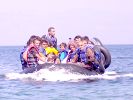Eye For Film >> Movies >> Another News Story (2017) Film Review
Another News Story
Reviewed by: Jennie Kermode

Brexit. Russian hacking scandals. The Olympic Games. They’re all big stories, and understandably so, but watching the way the news media report on them, one might almost forget that there are currently 22.5 million refugees in the world, that Europe is facing the biggest refugee crisis since the Second World War. Another News Story meets the journalists who are battling against the odds to keep that crisis in the headlines.
Remember the famous picture of little Aylan Kurdi washed up, dead, on a beach? It was a picture that hit a nerve, triggered real public horror and briefly propelled the crisis to the top of the news agenda. To the journalists on site, quite how it made such a big impression is a mystery, not because we shouldn't be horrified by the sight of dead children but because it's a sight they see all the time. The trouble is that now the public is familiar with Aylan Kurdi's tragic story, the next picture of a dead child won't get anything like as much attention. To news publishers and broadcasters, the ongoing deaths of children are an old story.

One way to combat this kind of disconnection is to make stories feel personal. Another News Story follows Mahasen, a Syrian woman who has travelled for hundreds of miles by the time we meet her, much of it on foot, trying to get to safey, trying to reunite her family. Intelligent, articulate and possessed of that matter-of-fact approach that often stems from trauma, she anchors the narrative, helping the viewer connect to other stories, such as that of a man who has dragged himself all the way from Afghanistan to the borders of Europe on crutches. We also meet a number of journalists, most notably the charismatic Johnny and Bruno, who act as guides to the larger story whilst gradually revealing their own. Over the course of the film, the pool of cameras slowly diminishes as reporters are recalled to headquarters or sent to fresher, newly horrifying disaster zones.
Working around human suffering for prolonged periods takes its toll. Some people simply can't cope. Those who do develop a kind of distance of their own; for all that what they see may make them angry, they recognise their individual inability to make much difference, and get beyond the urge to give away their own food, money and warm coats. Dead children become part of life. This, too, is something that has to be managed.It's difficult to create emotive narrativeswhen one's own emotions are numb; everything starts to feel like propaganda. The journalists here talk about human suffering as if they were discussing the latest football results. Traditional methods of discerning virtue become moot. Those doing the most good may be the least inclined to cry.
There's strong stuff here, but for the very reasons the film describes, it's often difficult to connect with. Each year brings more films about the refugee crisis. We have heard many of these arguments before, and seen these images, and whilst director Orban Wallace works hard to try and resensitise us, ultimately this is just another documentary. Perhaps this is how the world ends: with a bang that our accustomed ears hear only as a whimper.
Reviewed on: 21 Feb 2018

















